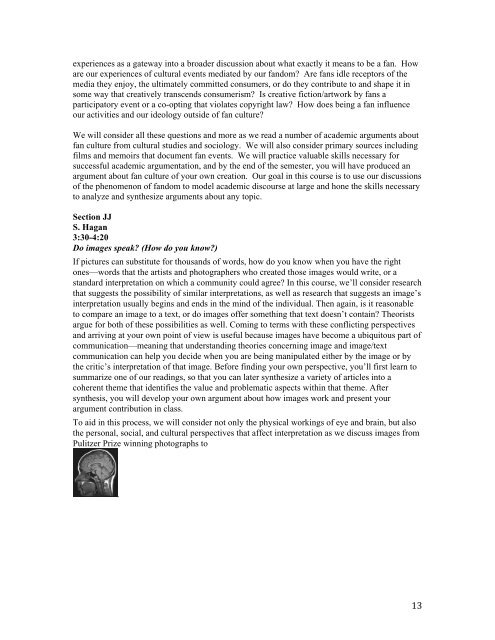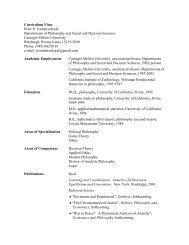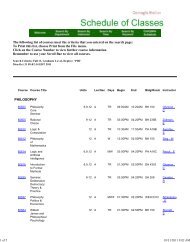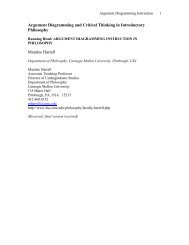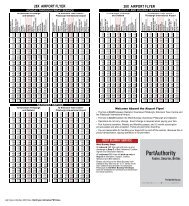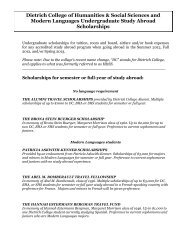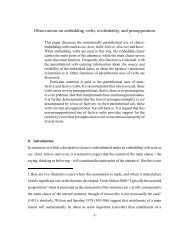First-Year English Program - College of Humanities and Social ...
First-Year English Program - College of Humanities and Social ...
First-Year English Program - College of Humanities and Social ...
You also want an ePaper? Increase the reach of your titles
YUMPU automatically turns print PDFs into web optimized ePapers that Google loves.
experiences as a gateway into a broader discussion about what exactly it means to be a fan. How<br />
are our experiences <strong>of</strong> cultural events mediated by our f<strong>and</strong>om? Are fans idle receptors <strong>of</strong> the<br />
media they enjoy, the ultimately committed consumers, or do they contribute to <strong>and</strong> shape it in<br />
some way that creatively transcends consumerism? Is creative fiction/artwork by fans a<br />
participatory event or a co-opting that violates copyright law? How does being a fan influence<br />
our activities <strong>and</strong> our ideology outside <strong>of</strong> fan culture?<br />
We will consider all these questions <strong>and</strong> more as we read a number <strong>of</strong> academic arguments about<br />
fan culture from cultural studies <strong>and</strong> sociology. We will also consider primary sources including<br />
films <strong>and</strong> memoirs that document fan events. We will practice valuable skills necessary for<br />
successful academic argumentation, <strong>and</strong> by the end <strong>of</strong> the semester, you will have produced an<br />
argument about fan culture <strong>of</strong> your own creation. Our goal in this course is to use our discussions<br />
<strong>of</strong> the phenomenon <strong>of</strong> f<strong>and</strong>om to model academic discourse at large <strong>and</strong> hone the skills necessary<br />
to analyze <strong>and</strong> synthesize arguments about any topic.<br />
Section JJ<br />
S. Hagan<br />
3:30-4:20<br />
Do images speak? (How do you know?)<br />
If pictures can substitute for thous<strong>and</strong>s <strong>of</strong> words, how do you know when you have the right<br />
ones—words that the artists <strong>and</strong> photographers who created those images would write, or a<br />
st<strong>and</strong>ard interpretation on which a community could agree? In this course, we’ll consider research<br />
that suggests the possibility <strong>of</strong> similar interpretations, as well as research that suggests an image’s<br />
interpretation usually begins <strong>and</strong> ends in the mind <strong>of</strong> the individual. Then again, is it reasonable<br />
to compare an image to a text, or do images <strong>of</strong>fer something that text doesn’t contain? Theorists<br />
argue for both <strong>of</strong> these possibilities as well. Coming to terms with these conflicting perspectives<br />
<strong>and</strong> arriving at your own point <strong>of</strong> view is useful because images have become a ubiquitous part <strong>of</strong><br />
communication—meaning that underst<strong>and</strong>ing theories concerning image <strong>and</strong> image/text<br />
communication can help you decide when you are being manipulated either by the image or by<br />
the critic’s interpretation <strong>of</strong> that image. Before finding your own perspective, you’ll first learn to<br />
summarize one <strong>of</strong> our readings, so that you can later synthesize a variety <strong>of</strong> articles into a<br />
coherent theme that identifies the value <strong>and</strong> problematic aspects within that theme. After<br />
synthesis, you will develop your own argument about how images work <strong>and</strong> present your<br />
argument contribution in class.<br />
To aid in this process, we will consider not only the physical workings <strong>of</strong> eye <strong>and</strong> brain, but also<br />
the personal, social, <strong>and</strong> cultural perspectives that affect interpretation as we discuss images from<br />
Pulitzer Prize winning photographs to<br />
.<br />
13


